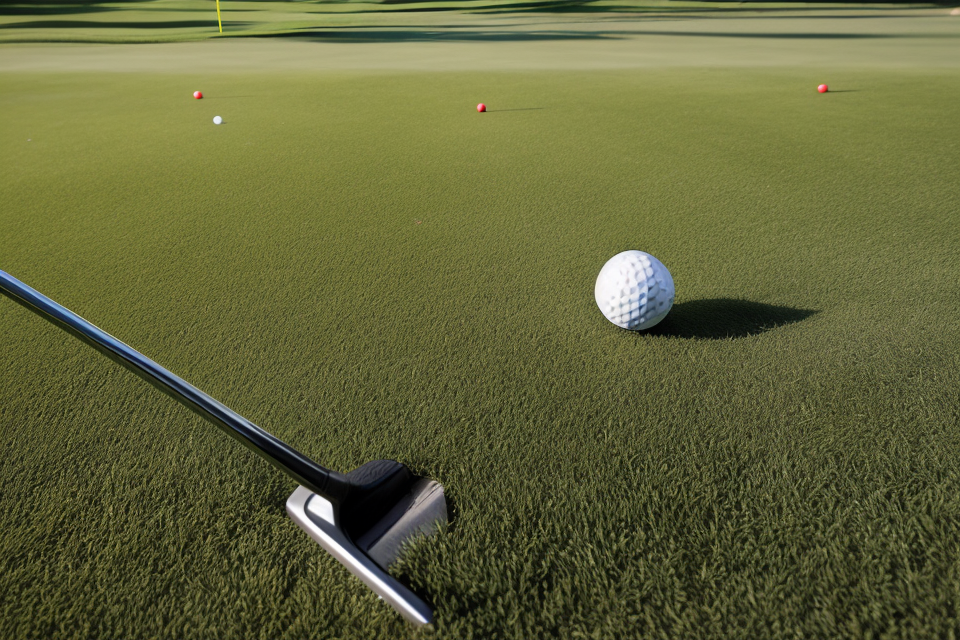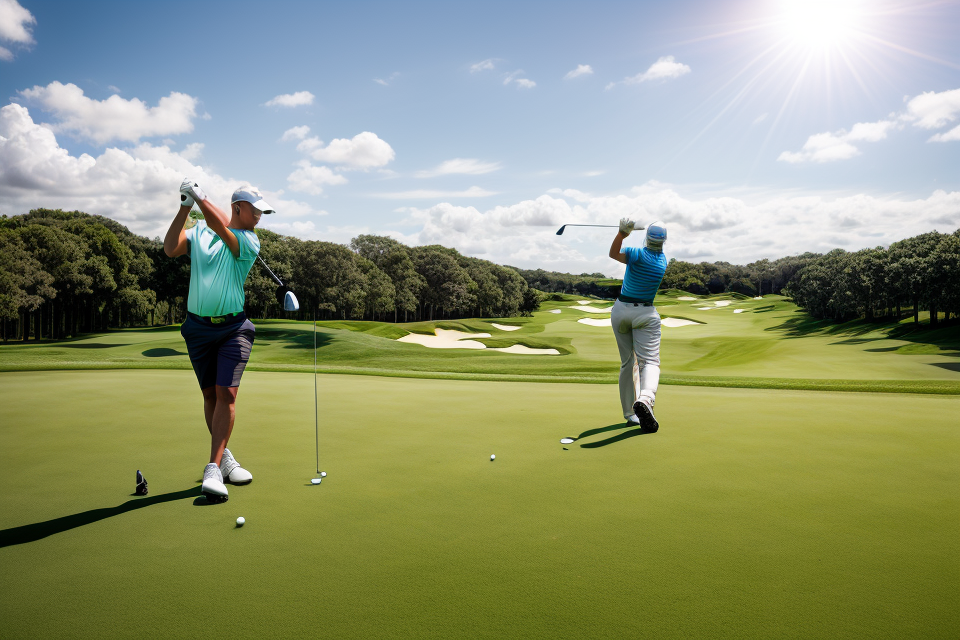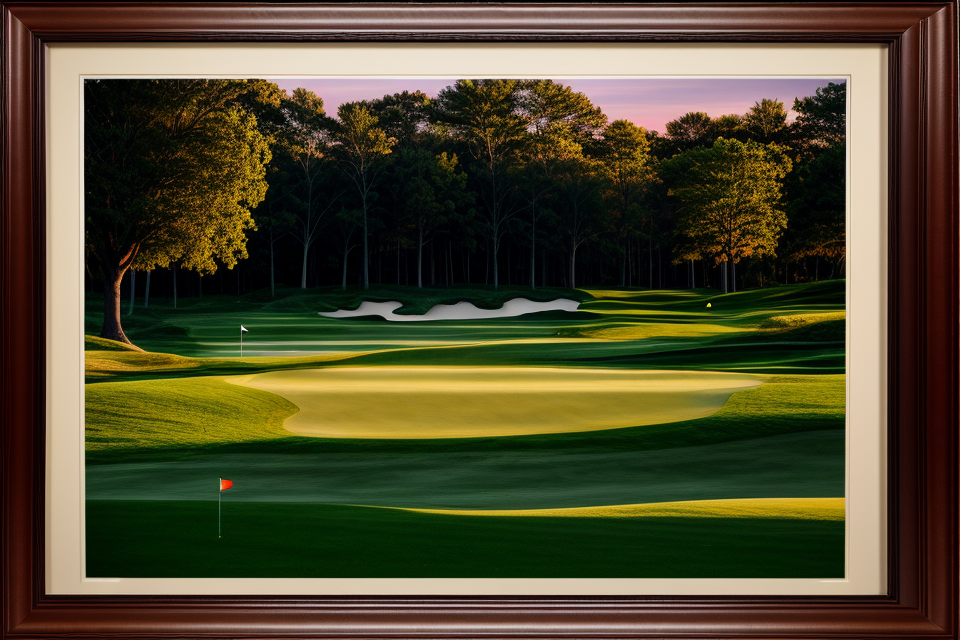
Golf is a sport that requires precision, skill, and a whole lot of patience. But with so many clubs to choose from, it’s hard to know which ones will make the biggest difference in your game. Do golf clubs really matter? Can a new set of clubs turn you into a pro overnight? In this article, we’ll explore the role of golf clubs in your game and whether or not they can truly make a difference. From drivers to putters, we’ll take a closer look at each club and its impact on your performance. So grab your clubs and let’s get started!
The answer to whether golf clubs really make a difference in your game is both yes and no. On one hand, the right golf clubs can help improve your swing and accuracy, resulting in better performance on the course. On the other hand, a skilled golfer with well-developed swing techniques can perform just as well with lower-end clubs as with high-end ones. Ultimately, the impact of golf clubs on your game depends on a variety of factors, including your skill level, swing mechanics, and playing style. Therefore, it’s important to carefully consider your individual needs and preferences when selecting golf clubs, and to practice regularly to improve your overall game.
Factors Affecting Golf Performance
Swing Mechanics
When it comes to golf clubs, the most important factor in determining their effectiveness is the golfer’s swing mechanics. Swing mechanics refer to the way in which a golfer moves their body and golf club during the swing. There are several factors that affect swing mechanics, including:
Golf Club Design and Weight Distribution
The design of a golf club can have a significant impact on a golfer’s swing mechanics. For example, a golf club with a heavy head can make it more difficult for a golfer to control their swing, while a golf club with a lightweight shaft can make it easier for a golfer to swing the club faster. Additionally, the weight distribution of a golf club can affect its balance and feel during the swing, which can in turn affect the golfer’s swing mechanics.
Shaft Flex and Kickpoint
The flex of a golf club shaft can also affect a golfer’s swing mechanics. A shaft that is too flexible can cause the clubhead to twist during the swing, which can lead to poor contact with the ball. On the other hand, a shaft that is too stiff can make it difficult for a golfer to control their swing. The kickpoint of a golf club shaft refers to the point at which the shaft begins to bend during the swing. A shaft with a higher kickpoint can provide more control and stability during the swing, while a shaft with a lower kickpoint can provide more feel and flexibility.
Grip Size and Shape
The size and shape of a golf club grip can also affect a golfer’s swing mechanics. A grip that is too small or too large can make it difficult for a golfer to maintain control of the club during the swing. Additionally, a grip that is too round or too flat can affect the golfer’s ability to control the club during the swing.
Ball Flight Characteristics
Golf club technology has evolved significantly over the years, leading to various club designs that cater to different golfers’ needs. While some may argue that clubs do not make a significant difference in one’s game, it is crucial to understand the role they play in determining ball flight characteristics. In this section, we will explore how golf clubs influence three key aspects of ball flight: spin rate and backspin, launch angle and ball speed, and carry distance and rollout.
- Spin rate and backspin
Spin rate refers to the amount of backspin generated by the golf ball upon impact with the clubface. A higher spin rate leads to a lower ball flight, while a lower spin rate results in a higher ball flight. The design of golf clubs, specifically the loft angle and the grooves on the clubface, plays a crucial role in determining the spin rate. For instance, wedges have a higher loft angle and deeper grooves, which generate more spin and result in higher shot control, especially around the green.
- Launch angle and ball speed
Launch angle is the angle at which the golf ball leaves the clubface, and it directly affects the ball flight. A higher launch angle leads to a higher ball flight, while a lower launch angle results in a lower ball flight. The design of golf clubs, such as the driver, can influence the launch angle. For example, a driver with a lower loft angle promotes a lower launch angle and longer carry distance, while a driver with a higher loft angle promotes a higher launch angle and shorter carry distance.
- Carry distance and rollout
Carry distance refers to the distance the golf ball travels through the air before landing on the fairway. A higher carry distance is typically associated with a higher ball flight, while a lower carry distance results in a lower ball flight. The design of golf clubs, such as the shaft and the clubhead, plays a crucial role in determining the carry distance. For instance, a shaft with a higher flex point promotes a higher launch angle and longer carry distance, while a shaft with a lower flex point promotes a lower launch angle and shorter carry distance.
In conclusion, golf clubs do make a difference in one’s game, as they influence critical aspects of ball flight, such as spin rate and backspin, launch angle and ball speed, and carry distance and rollout. Golfers can benefit from understanding these factors and selecting clubs that best suit their swing and playing style.
Personal Physical Factors
When it comes to golf performance, personal physical factors play a significant role. These factors include body type and swing style, strength and flexibility, and mental and physical fatigue.
- Body Type and Swing Style: Every golfer has a unique body type and swing style. A golfer’s body type affects their ability to swing the club, and their swing style affects the ball’s trajectory and distance. For example, a golfer with a shorter swing may benefit from using a driver with a lower loft angle to generate more distance, while a golfer with a longer swing may benefit from using a driver with a higher loft angle to generate more control.
- Strength and Flexibility: A golfer’s strength and flexibility also play a role in their performance. Golfers with stronger muscles can generate more power, while those with greater flexibility can make more precise shots. Additionally, having good core strength can help improve balance and stability during the swing.
- Mental and Physical Fatigue: Mental and physical fatigue can also impact a golfer’s performance. Golfers who are tired or mentally fatigued may struggle to maintain focus and make consistent shots. On the other hand, golfers who are well-rested and mentally sharp can perform at their best.
In conclusion, personal physical factors such as body type and swing style, strength and flexibility, and mental and physical fatigue can all impact a golfer’s performance. Therefore, it is important for golfers to take these factors into consideration when selecting and using golf clubs.
The Importance of Club Fitting
Understanding Your Game
- Identifying your strengths and weaknesses
- Assessing your swing characteristics
- Determining your ball flight tendencies
One of the most important factors in determining the impact of golf clubs on your game is understanding your own strengths and weaknesses as a golfer. By identifying the areas where you excel and those where you struggle, you can make informed decisions about the types of clubs that will best suit your game.
For example, if you are a long driver but struggle with accuracy, you may want to consider clubs that offer more control and precision rather than simply looking for the longest possible shaft. On the other hand, if you are consistently short on distance but have a good handle on accuracy, you may want to focus on clubs that will help you reach the green in regulation.
In addition to identifying your strengths and weaknesses, it is also important to assess your swing characteristics. Different golf clubs are designed to work with different swing types, so it is important to understand your own swing and what types of clubs will work best for you. For example, if you have a slow, smooth swing, you may benefit from clubs with a higher degree of forgiveness, while a faster, more aggressive swing may be better suited to clubs with a lower profile and more precise design.
Finally, it is important to determine your ball flight tendencies. By understanding how your ball tends to fly through the air, you can make informed decisions about the types of clubs that will help you control your shots and achieve the desired outcome. For example, if you tend to slice the ball, you may want to consider clubs with a higher loft to help keep the ball on the fairway, while a hooker may benefit from clubs with a lower loft and a more draw-biased design.
Overall, understanding your own game is crucial to making the most of your golf clubs. By taking the time to assess your strengths and weaknesses, swing characteristics, and ball flight tendencies, you can ensure that you are equipped with the right tools to achieve your goals on the course.
Customizing Your Equipment
One of the most critical aspects of improving your golf game is ensuring that you have the right equipment. While many golfers might opt for the latest and most expensive clubs on the market, it’s important to remember that what works for one player might not work for another. This is where club fitting comes in, and why customizing your equipment is crucial to your success on the course.
Customizing your equipment begins with determining the proper club length and lie angle. These two factors are essential in ensuring that you are able to make solid contact with the ball and maintain control over your shots. A club that is too long or too short can lead to mis-hits and a loss of accuracy, while a club with the wrong lie angle can result in a slice or a hook.
Adjusting clubhead speed and spin rate is another crucial aspect of customizing your equipment. Each golfer has a unique swing speed and ball spin rate, and it’s important to find clubs that are tailored to your specific needs. A clubhead that is too heavy or too light can affect your swing speed and cause you to hit the ball too high or too low, resulting in lost distance and accuracy.
Lastly, selecting the right shaft type and flex is essential to maximizing your performance on the course. The shaft is the backbone of your club, and it’s essential to find one that matches your swing speed and style. A shaft that is too stiff or too flexible can cause you to lose control over your shots, resulting in errant hooks or slices.
In conclusion, customizing your equipment is a crucial aspect of improving your golf game. By ensuring that you have the right club length, lie angle, clubhead speed, spin rate, and shaft type and flex, you can maximize your performance on the course and achieve the success you’ve been looking for.
Golf Club Brands and Models
When it comes to choosing the right golf clubs, there are countless brands and models to choose from. Some of the most popular brands include TaylorMade, Callaway, Titleist, and Ping. Each brand offers a range of clubs with varying levels of performance, and it’s important to find the ones that work best for your game.
Comparing top-rated clubs
When comparing different golf clubs, it’s important to look at their performance ratings. Many websites and magazines publish rankings of the top-rated clubs in various categories, such as drivers, irons, and wedges. These rankings can be a useful starting point for narrowing down your options.
Considering your budget and preferences
It’s also important to consider your budget and preferences when choosing golf clubs. Some clubs can be quite expensive, so it’s important to find a balance between performance and affordability. Additionally, you may have certain preferences when it comes to club design or materials, which can influence your decision.
Seeking professional advice and club fittings
One of the best ways to find the right golf clubs for your game is to seek professional advice and club fittings. Many golf stores and ranges offer club fittings, where a professional will help you select the right clubs based on your swing and playing style. This can be a great way to ensure that you’re using the best possible equipment for your game.
Myths and Misconceptions About Golf Clubs
One-Size-Fits-All Mentality
While it may be tempting to believe that a single set of golf clubs can accommodate the needs of all golfers, this simply isn’t the case. The truth is that every golfer is unique, with their own strengths, weaknesses, and swing styles. As such, it’s essential to understand that a one-size-fits-all mentality when it comes to golf clubs is misguided and can ultimately hinder your performance on the course.
The Importance of Individualized Equipment
One of the most important factors to consider when selecting golf clubs is the individual’s physical attributes and swing characteristics. These include factors such as height, weight, strength, and flexibility, as well as the golfer’s swing speed and trajectory. By taking these factors into account, golfers can ensure that they are using equipment that is tailored to their specific needs, which can ultimately lead to improved performance.
The Role of Personalization in Golf Club Performance
In addition to physical attributes, the golfer’s swing style and preferences also play a crucial role in determining the optimal set of golf clubs. For example, a golfer with a slow swing speed may benefit from using heavier clubs to increase ball speed and distance, while a golfer with a fast swing speed may prefer lighter clubs to maximize control and accuracy. Similarly, a golfer with a draw bias may opt for clubs with more loft, while a golfer with a fade bias may prefer clubs with less loft.
Ultimately, the most effective way to determine the optimal set of golf clubs for your game is to undergo a professional fitting. During a fitting, a trained professional can assess your physical attributes, swing characteristics, and preferences to help you select a set of clubs that is tailored to your specific needs. This can ultimately lead to improved performance, increased confidence, and a more enjoyable experience on the course.
Superstitions and Beliefs
Golf is a sport steeped in tradition and superstition, and this is especially true when it comes to the clubs that golfers use. Many golfers have certain beliefs and superstitions about the clubs they use, and these beliefs can range from the comically absurd to the deeply held.
One common myth is that certain club models or materials are “lucky” or “unlucky.” For example, some golfers believe that using a particular brand of driver will lead to a better game, while others believe that using a certain type of golf ball will improve their score. While there may be some small benefits to using certain brands or materials, there is no scientific evidence to support the idea that these clubs are “lucky” or “unlucky.”
Another popular misconception is that certain clubs are only useful for certain types of shots. For example, some golfers believe that a sand wedge is only useful for getting out of bunkers, while a lob wedge is only useful for hitting high, soft shots around the green. While it’s true that different clubs are designed for different types of shots, it’s important to remember that each club can be used in a variety of situations. A skilled golfer will be able to use any club in their bag to hit a variety of shots, depending on the situation.
Finally, some golfers believe that using a certain type of club will give them an unfair advantage over their opponents. For example, some golfers believe that using a longer driver will give them an advantage on longer holes, while others believe that using a putter with a unique design will give them an edge on the greens. While it’s true that certain clubs may have slight advantages in certain situations, it’s important to remember that golf is a game of skill, and using the right club for the situation is a key part of that skill.
Overall, while there may be some small benefits to using certain clubs or brands, it’s important to remember that golf is a game of skill, and the most important factor in improving your game is your own ability as a golfer. By focusing on developing your skills and technique, rather than relying on superstitions or beliefs about certain clubs, you’ll be well on your way to improving your game.
The Role of Technology in Golf Club Design
Golf club technology has evolved significantly over the years, leading to a wide range of innovations that have changed the game for golfers. This section will explore the role of technology in golf club design and how it has impacted club performance.
Evolution of Golf Club Technology
The first golf clubs were made of wood and were quite simple in design. Over time, golf club technology advanced with the introduction of steel shafts, graphite shafts, and different materials for clubheads. In recent years, there has been a significant increase in the use of technology in golf club design, with the development of new materials, manufacturing processes, and design techniques.
The Impact of Technology on Club Performance
Technology has had a significant impact on club performance, allowing golfers to hit the ball further and more accurately. For example, the use of titanium and other lightweight materials in clubheads has increased the speed and distance of shots. Additionally, the use of computer-aided design (CAD) and other digital tools has allowed designers to create clubs with precise dimensions and optimized shapes, resulting in improved accuracy and control.
Emerging Trends and Innovations
There are several emerging trends and innovations in golf club technology that are expected to continue to impact club performance in the future. For example, the use of 3D printing and other advanced manufacturing techniques is allowing designers to create clubs with more complex and precise shapes, resulting in improved performance. Additionally, the use of sensors and other data-tracking technologies is allowing golfers to analyze their swings and optimize their technique for maximum performance.
Overall, the role of technology in golf club design has had a significant impact on club performance, allowing golfers to hit the ball further and more accurately than ever before. As technology continues to advance, it is likely that we will see even more innovations in golf club design that will further improve the game for golfers of all skill levels.
FAQs
1. Do golf clubs really make a difference in your game?
Yes, golf clubs can make a significant difference in your game. The right set of golf clubs can help you hit the ball further, straighter, and with more control. It can also help you to play different shots and handle different course conditions. However, it’s important to note that while golf clubs can make a difference, they are not a magic solution and you still need to have good technique and practice to become a better golfer.
2. How do I know which golf clubs are right for me?
There are several factors to consider when choosing the right golf clubs, including your skill level, swing speed, and physical characteristics such as height and weight. A good way to start is to get fitted for clubs by a professional at a golf store or driving range. They can help you to determine the right club lengths, lofts, and flexes for your game. You can also try out different clubs on the driving range to see which ones feel best to you.
3. Are expensive golf clubs worth the investment?
Expensive golf clubs can be a good investment if you are a serious golfer and play frequently. High-end clubs are typically made with higher quality materials and technology, which can lead to improved performance and longer lifespan. However, they can also be quite expensive and may not be necessary for casual or beginner golfers. It’s important to consider your budget and playing ability when deciding whether to invest in expensive golf clubs.
4. Can I use the same golf clubs for all types of courses?
While it’s possible to use the same golf clubs for all types of courses, you may find that certain clubs are more useful on certain types of courses. For example, if you frequently play courses with narrow fairways, you may want to invest in a lower lofted driver to help you avoid the trees. Similarly, if you play courses with a lot of water hazards, you may want to invest in a higher lofted wedge to help you get out of bunkers.
5. How often should I replace my golf clubs?
The lifespan of golf clubs can vary depending on how often you play and how well you take care of them. As a general rule, you should consider replacing your clubs every 5-7 years. However, if you notice that your clubs are not performing as well as they used to, it may be time to upgrade to a newer model.


